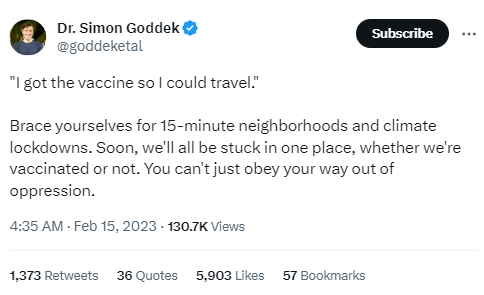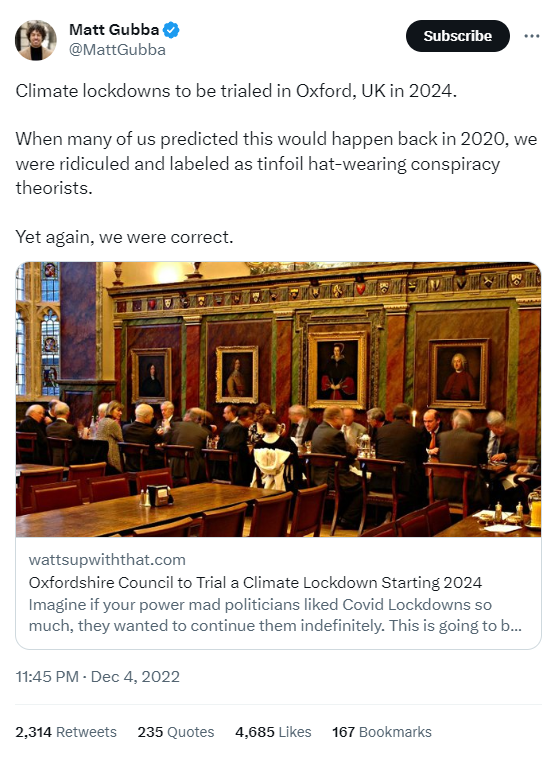How “Climate lockdowns” conspiracy theories target authorities undertaking climate action
An analysis of the EDMO fact-checking network. Organizations that contributed to this analysis: Science Feedback; AFP; Delfi; Demagog; DPA; DW; Factual.ro; Maldita.es; Newtral; Pagella Politica/Facta news; Re:Baltica; The Journal – FactChecking; Verificat.
This is a shortened version of the original article from Science Feedback – that contains an in-depth analysis of the top promoters of this narrative in English, French, German and Spanish, and details the methodology used – that you can read here.
In the early days of the COVID-19 pandemic, long before vaccines became available, many countries acted to curb the spread of the virus by imposing restrictions on people’s movement called lockdowns. Lockdowns have saved lives by reducing the physical interactions between infected and uninfected people, which in turn reduces transmission and the number of people infected[1-2]. In spite of their initial effectiveness at limiting the spread of the disease, there has been pushback against lockdowns and some even made conspiratorial claims that the purpose of lockdowns was for ‘global elites’ to control populations.
As the COVID-19 pandemic is receding, a new narrative has emerged about lockdowns, linking it to measures to address climate change. This “Climate lockdowns” narrative promotes the idea that governments and/or some ‘elites’ would be using climate change as an excuse for imposing new restrictions on people’s freedom of movement or to ‘control’ populations. These messages usually communicate to their audience that climate change mitigation policies are an intolerable infringement on their freedom.
The Institute for Strategic Dialogue’s (ISD) has written a detailed report on the narrative’s emergence. The ISD explained that when it emerged in late 2020, “continuous efforts by climate denialists to push the idea of a ‘climate lockdown’ failed to gain any traction”.
But the narrative started to gain traction in 2021 thanks in part to poorly written headlines, such as one in The Guardian for instance, which argued that carbon emissions reduction equivalent to those that happened during the COVID-19 lockdowns would be needed every two years to reach climate goals (see Figure 1). This and other articles by the World Economic Forum or Time Magazine were used by climate contrarians as evidence that “climate lockdowns” were a genuine concern.

Mentions of “climate lockdown” in the media and on social media then reached record levels in 2022 when a controversy emerged around Oxford city planning measures designed to reduce traffic congestion, and implement the “15-minute city” concept. While this urbanistic concept refers to having all amenities within a convenient 15-minute walking or biking distance, it was misrepresented by those pushing the climate lockdown narrative as an actual lockdown measure to confine people to their neighborhood (see Figure 2).
In a 2023 report, the Climate Action Against Disinformation (CAAD) coalition observed that “The term itself is arguably more neutral than ‘climate lockdown’, allowing it to gain traction and penetrate beyond more niche or issue-specific communities online”. The report argues that the “15-minute city” concept turned the “climate lockdown” narrative into “a new, but considerably more mainstream, conspiracy”.

During the Oxford controversy, these online narratives had consequences that affected the city’s daily life, with death threats being sent to Oxford local officials. Thousands also marched in the streets to protest, with placards repeating online claims.
Fact-checkers addressed “climate lockdowns” claims in Europe
Thousands of social media posts claiming that Oxford was planning a “Climate lockdown” by 2024 appeared all over Europe. In Croatia, Germany, France, and Poland, fact-checkers noticed posts misleading users by showing incomplete quotes and false information on decisions taken by Oxford local authorities.
Fact-checkers explained that while it is true that Oxford City Council and Oxfordshire County Council recently enacted measures, only one of them mentions 2024, and none can be labeled a “lockdown”. In reality, the 2024 measure was Oxfordshire County Council’s decision to install traffic filters on 6 roads in order to limit traffic congestion at peak hour.
Disinformation spreaders claimed the County Council planned to confine and control residents. To counter this claim, fact-checkers provided readers with evidence from the County Council’s website, indicating that its goal was primarily to reduce traffic jams, speed up bus journeys, and make walking and cycling safer.
Some social media posts propagated the idea that Oxford residents wouldn’t be able to move freely, and would be fined if they cross the city because of traffic filters. Fact-checkers at Agence France Presse, Deutsche Presse-Agentur, and Delfi provided evidence that traffic filters are only cameras able to read car plates. If residents pass through it at certain times of the day, they will receive a fine by mail. So Oxford residents won’t be prevented from traveling to any particular destination. During traffic filters’ operating hours, private cars might have to take a different route, but the city would still be accessible by car.
The second measure taken by the Oxford City Council that sparked disinformation on social media was a proposal to aim for “15-minute neighborhoods” in its 2040 agenda. Fact-checkers pointed out that this is different from the traffic filter measure and that it is only a proposal. Fact-checkers at Deutsche Welle, Verificat, Factual, and Maldita addressed claims that this proposal would confine residents within 6 districts, and control their daily lives.
In reality, the concept doesn’t include any restrictive boundary between each neighborhood. So there are no physical or theoretical barriers, nor limits for travels taking more than 15 minutes. The main objective, explained by Oxford authorities in a public statement, is to improve amenities in order to reduce long unnecessary travel. Fact-checkers gathered first-hand information interviewing law professors, urbanism experts, and Oxford authorities, who confirmed that the claims were misleading.
“No government, whatever the political color, can compel citizens not to leave or enter any part of the national territory [in Spain],” Ignacio Álvarez Rodríguez, an expert on constitutional law and professor at Complutense University of Madrid, told Verificat.
More similar claims later appeared, such as that the 15-minute city includes limits and sanctions related to residents’ purchases of meat and dairy products. That claim was based on a video of a Walmart shop with cameras, allegedly monitoring customers’ dairy and meat purchases. In Ireland, fact-checkers from The Journal explained that the video featured in the claims actually shows the monitoring of product stock level on shelves, and that the 15-minute city concept has nothing to do with monitoring or limiting what people purchase.
Simultaneously, claims that the European Union (EU) would be planning Climate lockdowns also spread in Spain, prompting fact-checkers at Maldita to investigate. A media outlet’s Twitter account, called ‘El Puntual 24H’, claimed that the EU already considered “Climate lockdowns” as a sanction for member states that exceed pollution targets, arguing that there is evidence in a 2018 sanction from the EU’s Court of Justice.
However, Maldita examined the sanction and found that it was unrelated to climate lockdowns. Advanced searches turned up no EU decisions corresponding to the claims. In fact, the EU never considered applying “Climate lockdowns”, as confirmed by the EU Commission to Maldita.
Social media dynamics related to the “Climate lockdowns” surge
To understand how the narrative propagated in Europe, we analyzed posts and videos from Twitter, Facebook, and YouTube mentioning keywords related to this narrative in different languages.

Our analysis reveals that prior to August 2022, the number of social media posts related to “Climate lockdowns” remained relatively low (see Figure 3). The first notable increase in the number of posts took place in August 2022, relating to claims linking climate change to the Great Reset conspiracy.
From then on, the narrative was featured in tweets every day, building up momentum until December 2022. During that month, posts and videos containing “Climate Lockdowns” narrative keywords spiked in relation to Oxford’s city planning claims described above. A tweet representative of content shared during this wave was posted on 4 December 2022 by an account with more than a hundred thousand followers.

In his tweet, the Twitter account links to an article from Watts Up With That, a climate contrarian blog that regularly publishes misinformation. This illustrates how the narrative reached the more traditional climate contrarian ecosystem, after being initially propagated by actors focused on COVID-19. The same trend appears on all three platforms analyzed. From December 2022 onward, the narrative remained present in a higher number of posts, notably on Twitter (see Figure 3).
On YouTube, top promoters found a large audience, and their videos spreading the narrative in English have been viewed hundreds of thousands of times on average. These videos often feature mentions of articles and conspiracy theories from other social media platforms, showing that disinformation on one platform feeds another. “We found most of the videos spread on TikTok: in various languages and with similar narratives” explains Deutsche Welle (DW) Science Editor Rachel Baig in an email to Science Feedback.
(…)
Potential for new “Climate lockdowns” disinformation campaigns
New claims of climate change mitigation measures being “Climate lockdowns” have sprouted all over Europe since late 2022. France’s banning of some short-haul domestic flights, Italy’s heat restrictions during winter 2022, the EU’s energy consumption targets for member states, or Canterbury’s plan to reduce car use were all claimed to be instances of climate lockdowns.
Most new “Climate lockdown” claims identified in 2023 come from regular social media users who haven’t gained enough traction to trigger a controversy similar to Oxford’s. Yet, the media has shown it has potential to amplify these deceptive talking points.
Indeed, our data shows that “Climate lockdowns” top promoters’ posts were shared 3 times more than politicians’ ones on Facebook when they come from a media account, and videos from media accounts amount to 82% of all top promoters’ views on YouTube.
The increasing number of measures to limit greenhouse gas pollution that can be expected in the future will certainly present opportunities for future weaponization and misrepresentation. Writers, editors, and journalists should be aware of these manipulation tactics when discussing the aftermath of COVID-19 restrictions or future climate policies, knowing that some actors are trawling for any evidence to boost the manufactured ‘climate lockdown’ outrage.
Charles Terroille, journalist at Science Feedback
Charlotte Samson, data scientist at Science Feedback
REFERENCES
- Megarbane et al. (2021) Is Lockdown effective in limiting SARS-CoV-2 epidemic progression?—a cross-country comparative evaluation using epidemiokinetic tools. Journal of General Internal Medicine.
- Flaxman et al. (2020) Estimating the effects of non-pharmaceutical interventions on COVID-19 in Europe. Nature.
